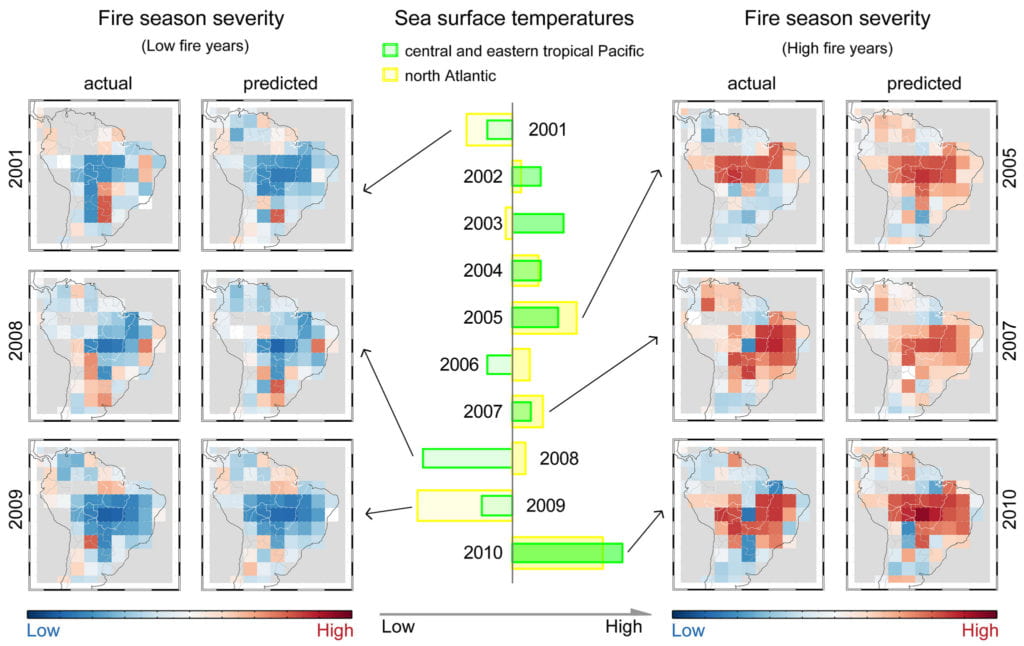Using water to predict fire
UCI researchers can forecast wildfires using sea surface temperatures.
As a boy in coastal San Diego in the 1980s, Jim Randerson loved the exotic fish, birds and even tides of red crustaceans that washed ashore during storms created by temperature changes in far-off seas. Across the globe, Yang Chen was a child in rural southeast China witnessing the pollution created by new manufacturing and power plants.
“I actually grew up at the same time that China was opening up and expanding. I saw the factories being built – and the effects on air and water,” he says.
Both are now in UC Irvine’s Department of Earth System Science, and their childhood experiences have led them to jointly produce compelling research, recently published in the journal Science.
Randerson and Chen proved that tiny temperature changes on the surface of distant oceans can be used to predict the severity of upcoming wildfire seasons in Amazon rainforests. These blazes often generate huge plumes of air pollution that can warm the climate and ocean waters even further, creating a vicious cycle.
“I’ve always viewed the Amazon as a giant pump that affects the global climate,” says Chen, an assistant project scientist and lead author of the paper. “There are so many processes going on that any perturbation in this ‘pump’ is worthwhile to study.”
Wildfires, once rare in tropical forests, have become a major threat to humans and biodiversity across an “arc of deforestation” in Brazil, Bolivia and Peru due to clear-cutting and agricultural burns. Randerson and Chen say the new
findings could aid fire and public health officials and broader efforts to stem climate change.
Rainforests are vital carbon dioxide storage basins, and woodlands consumed by fire across the southern continent are responsible for about a quarter of the greenhouse gases released from forests globally.
“This work has very clear implications for conserving tropical forests,” says Randerson, an Earth system science professor. “Understanding in advance whether you’re going to have an exceptionally bad fire year will become critically important for managing them.”
The prediction method he helped develop is similar to that for the storms that caught his attention as a child. Just as sea surface temperatures can unleash powerful Atlantic hurricanes or modify rainfall along the Pacific Rim, the two oceans can also intensify drought in the Amazon.
Utilizing NASA satellite weather data and maps of charred acreage and smoke plumes, the scientists painstakingly plotted a decade of water temperature variations and wildfire duration and intensity across central South America. They found that temperature increases of as little as a quarter of a degree on the Atlantic and a single degree Celsius on the Pacific matched up with more severe blazes across broad swaths of the Amazon over the next year.
“These changes are slight, but they trigger big effects in these tropical forest ecosystems,” Chen says. The ocean temperatures affect atmospheric winds and clouds that can reduce or increase rainfall over continents, he explains, adding: “It enables us three to five months in advance to predict the severity of the fire season.”
The researchers tested their method by forecasting – based on water temperature readings – South America’s 2010 fire season and then checking actual data afterward. Their accuracy was striking. During that year, large temperature increases occurred on both oceans, and several months later, the Amazon rainforest experienced severe drought, creating highly flammable conditions.
“We predicted a massive spike in fires in 2010, and it occurred,” says Randerson, citing conflagrations across hundreds of miles. In one Brazilian state, they had forecast worse fires than occurred, then learned that officials there had sharply reduced clear-cutting – and the prescribed burns that go with it.
The scientists plan to release their predictions soon for the upcoming 2012 fire season. The next step will be to see if the prediction method works for forests in Siberia, Indonesia and West Africa – and maybe someday in Southern California.
Other authors of the Science paper were Yufang Jin of UCI; George Collatz and Douglas Morton of NASA’s Goddard Space Flight Center; Ruth DeFries and Miriam Marlier of Columbia University; Prasad Kasibhatla of Duke University; and Louis Giglio of the University of Maryland.

